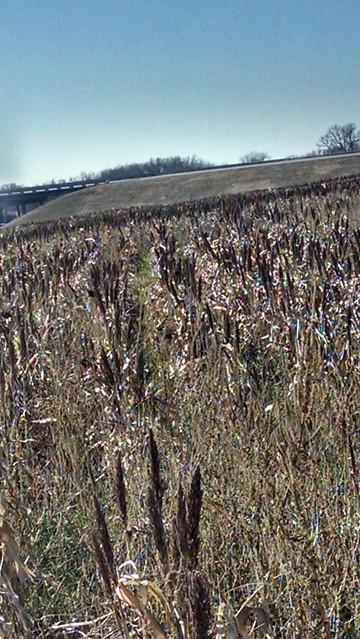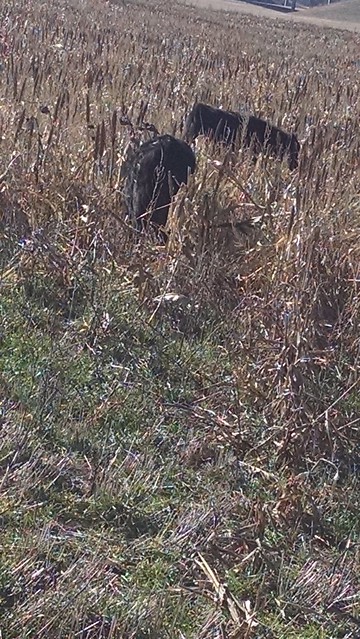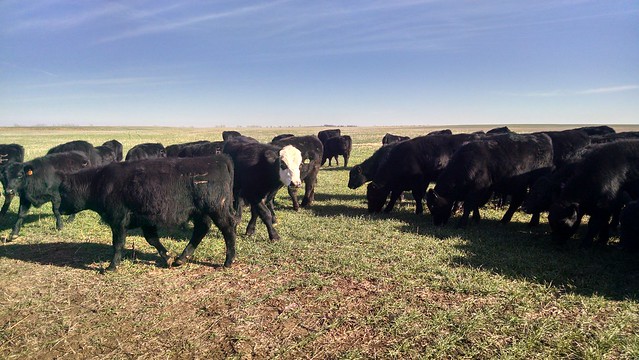Authors note: Much of this is my recap of the 2012 No Till on the Plains Winter Conference. I went into the conference wanting to wrap my mind around utilizing cover crops in no till better. I still have many questions, but they might be best answered from experimenting.
Implementing cover crops in no till cropping systems has been a concept introduced to me at the No Till on the Plains winter conference a couple of years ago. Cover crops are plants seeded and grown between cash crops. These plants can be legumes that takes nitrogen from the air for the plant to use, brassica's that are deep rooted that help break compacted layers of soil and trap nitrogen, or grasses that hold soil and take up nutrients.
Gabe Brown, North Dakota farmer and rancher, was the first farmer that really got me interested in this crazy idea. He had found that a complex blend of plant species with varying root depths not only survived, but thrived in through North Dakota droughts. In the initial presentation a few years ago he talked about grazing cow/calf pairs for a month on a cover crop blend, I think he estimated the weight gain on the calves generated $100 or more an acre, that really perked my interest. At his presentation this past winter we told of a corn crop planted in a cover crop blend of cereal rye, vetches, oil seed radishes, turnips and a variety of other plants species. His cost of production was $1.10/bu he made one herbicide application to terminate the rye and set back the vetch enough to not compete with the corn and the cover crop blends provided all the nutrients. The expenses for his cover crops were covered by grazing them with cattle. He showed pictures of a corn crop that was planted into some of the heaviest ground cover of I've ever seen, at around tassel stage the trash was very deteriorated, at harvest the space between the rows were bare with the exception of some vetch that looked about a foot tall, and a couple of weeks later the vetch really started growing.
So Gabe Brown had luck with his cover crops during North Dakota droughts, but how would they deal with a Kansas drought? Gail Fuller, east central Kansas and Ryan Speer, south central Kansas, each gave presentations about their use of cover crops in last summer's drought.
Fuller has had cover crops longer in his rotation and felt early in the season his corn had the potential to be some of his best ever. He showed pictures of it green where his neighbor's corn was burned up from the drought, but relief from the drought came too late for it. After harvesting as forage he planted cover crop blends back to it to protect the soil and keep soil ecology working. The cover crops looked like they had good growth in his photos.
Ryan Speer is transitioning cover crops to his crop rotation and has experimented some the past few years. Speer's dryland corn was horrible, I think he said it yielded in the 15 to 20 bushel per acre range this year, but he noticed his yield monitor jumped up to 60 to 70 bushel range in a spot where there had been a plot of sun hemp between wheat crops three years ago. He stated that evaporation in the fairly short fallow period, late June to early October, is more than the water requirements of many of the cover crops. Speer has also been having rye and radishes flown on to irrigated corn fields late in the irrigation season. These are some very sandy field and he's seen an increase in soil organic matter to help increase both the water holding capacity and fertility of these fields.
So how do I tell how much nutrients are these cover crops are either tying up to be released when they decompose or nitrogen they are "making" in the case of legumes? Ray Ward of
Ward Lab, recommends farmers either estimate how many tons of hay the cover crop may make and determine protein value of the various plants or send a vegetative sample from one square yard for a cover crop analysis. Many cover crop advocates emphasizing some very diverse mixes so I feel sending a sample would be more helpful.
How do cover crops effect soil biology? Dr. Jill Clapperton soil biologist and president of Rhizoterra Inc explained that poor soil biology produced poor crops in terms of both crop yields and nutrient content. She went on to tell us that most soil organisms are fed by the soil organic matter and when cover crops are used there are more actively growing roots throughout the entire growing season to keep producing soil organic matter. She also stated that the more diverse mix of plants that are growing on top of the soil the more diversity in soil organisms, since a monocropping system is used for cash crops this leaves cover crops to be a major source of plant diversity. Earth worms are one of the biggest and easiest to recognize soil organisms and they absolutely dislike soils that have had mechanical tillage performed. Mechanical tillage disrupts the soil organisms that earth worms live on.
Fuller commented on having part of a field that was poor even though soil tests revealed that fertility was the same as the rest of the field. A mycorrhizea test revealed that it was severely out of balance there. Clapperton mentioned that Ward Lab and a few others are capable of testing for it now. Determining which cover crops helps correct mycorrhizea problems is a challenge.
I sat in a presentation of Dr. Jonathan Lundgren an entomologist with USDA-ARS, stationed at North Central Agriculture Research Laboratory, Brookings, South Dakota. He does extensive research and studying of predator insects. He stressed that reducing soil disturbance and careful scouting and using insecticides only when thresholds are met are a help preserve insect predators. He felt cover crop blends are helpful in recruiting more predators insects to fields to reduce need for insecticides.
I ran into a neighbor, Craig Ballou, he had a stop on a sunflower crop tour last summer at a double crop sunflower field without commercial nitrogen fertilizer. The field had been in a sun hemp cover crop between two wheat crops. It's a common practice of no till farmers in my area to raise two continuous crops of wheat. From past soil tests on double crop sunflowers in this rotation the nitrogen left was the same as what he had applied so he decided to not apply it. With our winter wheat growing season the soil doesn't warm soon enough for the residual nitrogen from a legume to be available for the wheat other than a possible protein boost.
 Here are Craig Ballou's double crop sunflowers on August 30th. No nitrogen fertilizer was applied and Craig said they did very good, I could tell he was proud of them when I asked him about them.
Here are Craig Ballou's double crop sunflowers on August 30th. No nitrogen fertilizer was applied and Craig said they did very good, I could tell he was proud of them when I asked him about them. I feel transitioning to cover crops is the next step in our no till rotation. I feel it will be a fairly slow transition as we learn what mix of plants and how to seed them in a timely manner. We will need to start on land we own, partially to insure we receive the long term benefits of it and to also prove to landlords that this crazy idea is viable.





